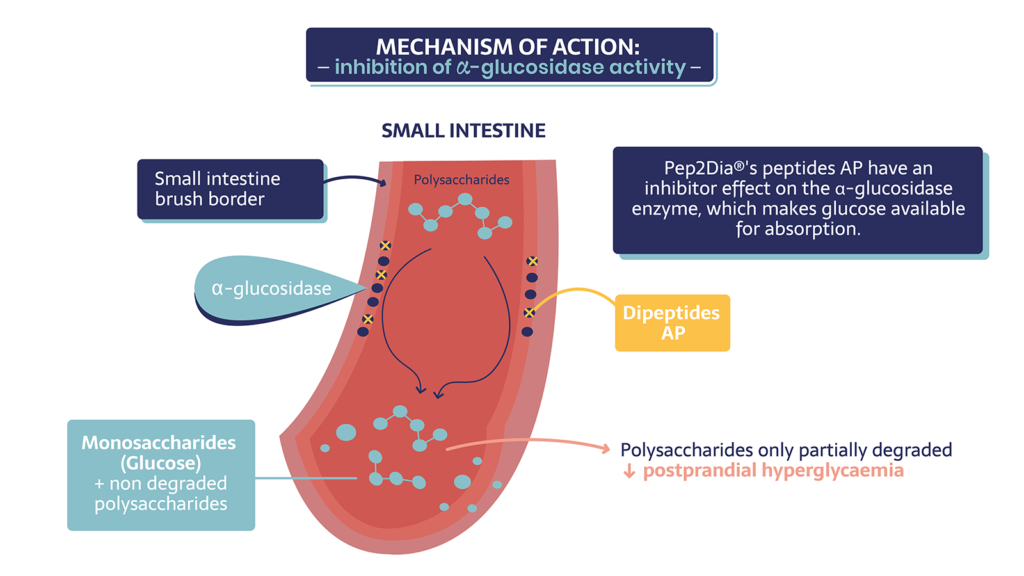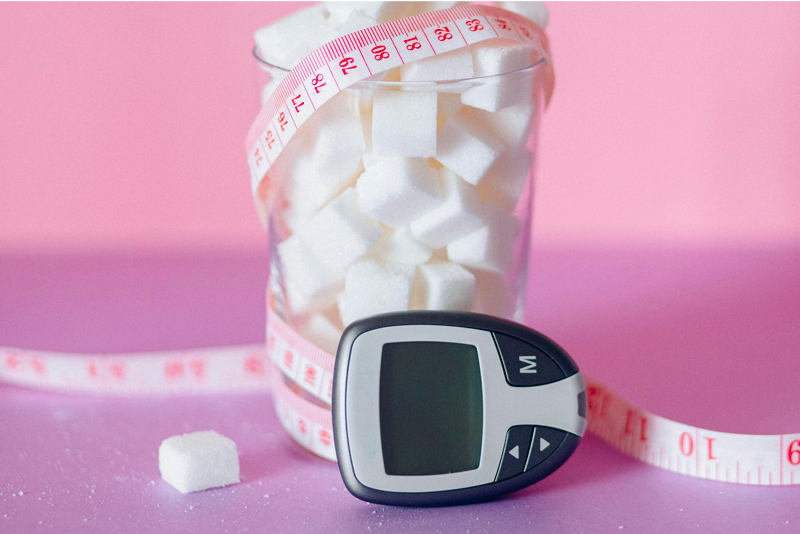
The Pep2Dia® action for better blood sugar management
Focus on how the body functions during carbohydrate consumption
Macronutrients (carbohydrates, proteins and lipids) and micronutrients (minerals and vitamins) are essential for the proper functioning of the body and are provided through our nutrition.
Carbohydrates (sugars) provide vital energy for the body which will primarily burn calories to operate our basal metabolism (functioning of the body at rest for, among other things, breathing, heartbeat, brain function etc.). Consuming carbohydrates is therefore essential for good health.
There are two types of carbohydrates: complex carbohydrates (or sugars), which comprise large molecules devoid of sweet taste, and simple carbohydrates, small molecules which provide a sweet taste.
When we consume complex carbohydrates, or oligosaccharides, an enzyme in the intestine called alpha-glucosidase splits these complex sugars into a simple sugar, glucose, to allow them to be assimilated into the body.
Once transformed, glucose can cross the wall of the intestine and circulate in the body via the bloodstream to provide the sources of energy necessary for the proper functioning of our bodies; this is our glycaemia (blood sugar level). So, glucose levels essential for our bodies vary naturally throughout the day, with a significant increase occurring just after meals as these are a source of carbohydrate intake.
Following the ingestion of carbohydrates, the body regulates blood sugar levels by producing insulin in the pancreas. This allows glucose to pass more easily into the cells and optimises glucose storage in the liver as well as in muscles in the form of glycogen (the first energy reserve activated by the body). This whole mechanism helps lower blood sugar.
Pep2Dia®, acting to keep blood sugar healthy
Naturally helping the metabolism to better regulate blood sugar levels, and in particular hyperglycaemia, means staying healthy for longer and putting less strain on the body.
Based on this observation and on scientific studies showing that the consumption of high-protein dairy products makes it possible to reduce blood sugar levels, CNRS’s LIENSs laboratory, in partnership with La Rochelle University and Ingredia, a company specialising in milk processing, developed Pep2Dia®, a bioactive ingredient derived from milk proteins that is 100% French and natural.

Pep2Dia® is produced through the hydrolysis of milk protein (breaking it down into small parts). This hydrolysate contains an AP (alanine-proline) dipeptide which has the property of inhibiting alpha-glucosidase, the intestinal enzyme responsible for converting complex sugars into simple sugar (glucose).
So, thanks to its composition, Pep2Dia® makes it possible to reduce blood sugar content after a meal (postprandial glycaemia)1
It is recommended to take Pep2Dia® at a 700mg dose before meals, twice a day.
Pep2Dia® can be easily integrated into the composition of food supplements (tablets, capsules…)
1Biotesys, 2022

Continue reading :
- Patented Pep2Dia® for the prevention of type 2 diabetes
- Focus on the results of Pep2Dia® preclinical and clinical studies
- Pep2Dia®, a natural product from the French dairy sector
- Pep2Dia®, an ingredient guaranteed free of side effects and toxicity
- Where does Pep2Dia® come from (origin, production etc.)?
Contact us
Our latest publications
Want to learn more about topics related to blood sugar management?
Here are our most recent blog posts!


Contact information
51 Avenue F. Lobbedez
CS 60946
62033 Arras Cedex
France
Tel : +33 (0)3 21 23 80 00
Fax : +33 (0)3 21 23 80 01



